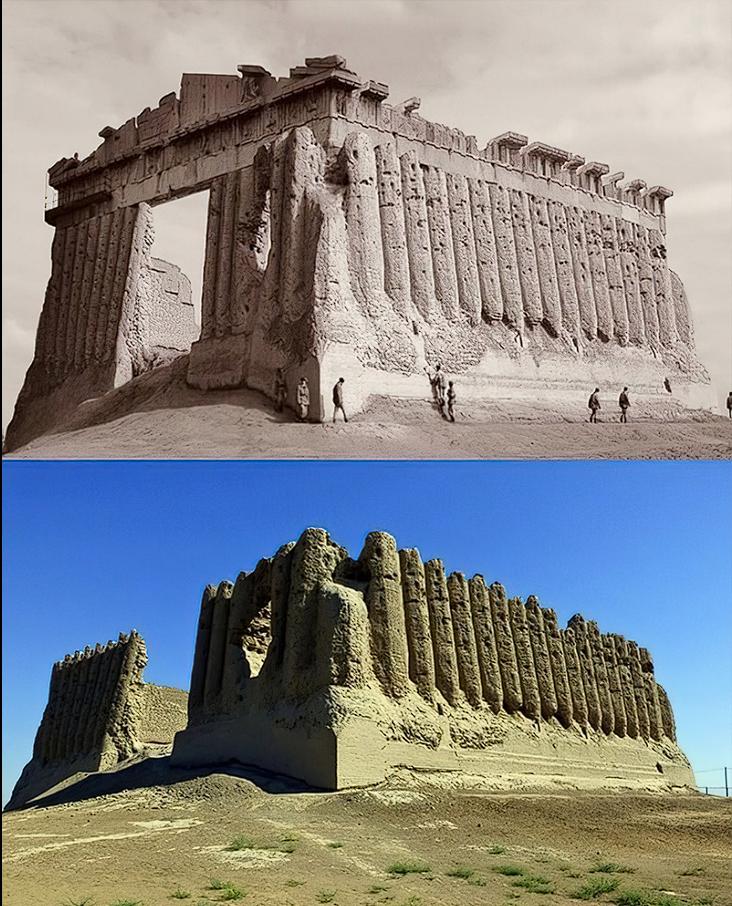Merv, an ancient city near modern-day Mary in Turkmenistan, boasts an extraordinary history spanning from the 3rd millennium BC to the 18th century AD. Its ruins, including the iconic Great Kyz Kala with its massive corrugated mudbrick walls, stand as a testament to its longevity and its pivotal role as a crossroads of civilizations on the Silk Road.
A City Through Time: Merv’s Enduring Habitation
- Ancient Origins: Millennia of History:
- Merv’s habitation spans an astonishing 5,000 years, from the Bronze Age to the medieval era, showcasing its enduring significance.
- This remarkable timeline highlights Merv’s ability to adapt and thrive under various empires and cultural influences.
- This long history, makes Merv, an important archeological site.
- Great Kyz Kala: Architectural Marvel:
- The Great Kyz Kala, a fortress with massive corrugated mudbrick walls, is a hallmark of Merv’s unique architectural style.
- This structure exemplifies the ingenuity and craftsmanship of the people who inhabited the region.
- This building, is a symbol, of Merv.
- Strategic Location: A Hub on the Silk Road:
- Merv’s location along the Silk Road, the ancient trade network connecting East and West, contributed to its prosperity and cultural exchange.
- The city served as a vital hub for merchants, scholars, and travelers, facilitating the exchange of goods and ideas.
- Its location, made it a central point of trade.
A Crossroads of Empires: Cultural Exchange and Evolution
- Achaemenid Persians: Early Influence:
- Merv flourished under the rule of the Achaemenid Persians, one of the earliest empires to leave its mark on the city.
- Their influence contributed to Merv’s development as a significant urban center.
- The Persians, were one of many empires, to rule Merv.
- Alexander the Great and the Seleucids: Hellenistic Legacy:
- Alexander the Great’s Macedonians and the subsequent Seleucid dynasty also played a crucial role in Merv’s history.
- They introduced Hellenistic influences, contributing to the city’s cosmopolitan character.
- Their rule, brought new cultural influences.
- Layered History: Architectural and Cultural Evolution:
- Each empire that ruled Merv contributed to its layered history, resulting in a rich tapestry of cultural exchange and architectural evolution.
- The city’s ruins reflect this diverse heritage, showcasing a blend of styles and influences.
- The ruins, show the diverse history, of the city.
Merv Today: A Testament to Ancient Civilizations
- Ruins as a Legacy: Historical Significance:
- The ruins of Merv today serve as a testament to the city’s longevity and its role as a crossroads of civilizations.
- They offer valuable insights into the lives, cultures, and interactions of the people who inhabited the region.
- The ruins, are a valuable historical record.
- Cultural Exchange: Convergence of Empires:
- Merv’s history highlights the convergence of traders, scholars, and empires across millennia, fostering a vibrant exchange of ideas and goods.
- The city’s legacy underscores the interconnectedness of ancient civilizations.
- Merv, was a melting pot of cultures.
- Preserving History: Archaeological Importance:
- The preservation and study of Merv’s ruins are essential for understanding the history of the Silk Road and the broader region.
- Archaeological efforts continue to uncover new insights into the city’s past, ensuring its legacy endures.
- Archeological studies, continue to reveal, new information.
Merv’s ruins stand as a powerful reminder of the city’s enduring significance as a crossroads of civilizations on the Silk Road. Its layered history, spanning millennia, offers invaluable insights into the cultural exchange and architectural evolution that shaped the ancient world.

CÁC TIN KHÁC
Mary Walton: The Forgotten Inventor Who Helped Clean Up America’s Cities
Tomb of Queen Nefertari in the Valley of the Queens, Egypt
Discover the Hypostyle Hall of the Temple of Hathor at Dendera
Venus de Losange: Unveiling the Mystery of a 20,000-Year-Old Paleolithic Icon